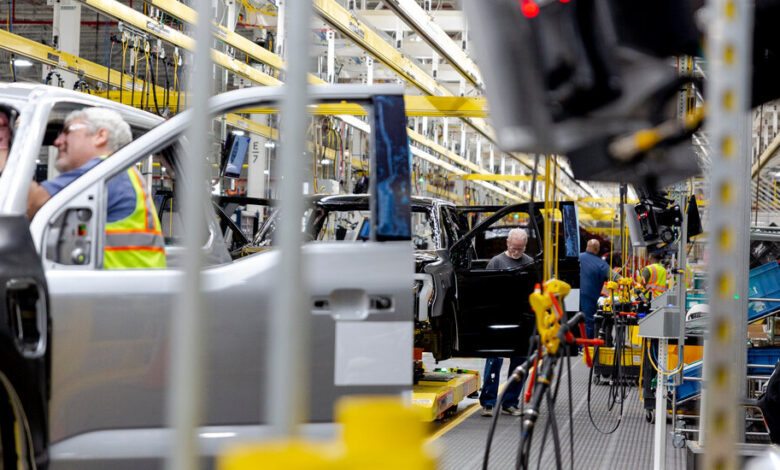Ford to Cut 3,000 Jobs to Reduce Costs in Transition to Electric Vehicles

Ford Motor is preparing to cut 3,000 jobs as part of a drive to reduce costs and become more competitive amid the auto industry’s transition to electric vehicles.
The company plans to eliminate the jobs of 2,000 salaried workers, mostly in the United States and Canada, and about 1,000 people employed by agencies that work as part of Ford’s operations, Ford told employees in a companywide email on Monday.
“We have an opportunity to lead this exciting new era of connected and electric vehicles,” the email said. Making this transition “means redeploying resources and addressing our cost structure, which is uncompetitive versus traditional and new competitors.”
The email was signed by Ford’s executive chairman, William C. Ford Jr., and its chief executive, Jim Farley. The company has about 31,000 salaried workers in North America.
Mr. Farley has signaled several times this year that the company was preparing to cut jobs and lower costs. The current round of job cuts follows a smaller one in April, when Ford laid off 580 salaried employees.
Read More on Electric Vehicles
- Inflation Reduction Act: The law extends tax incentives in an effort to steer more U.S. consumers toward electric cars. But new rules complicate the qualification process.
- Plug-In Hybrids: After falling behind all-electric cars, U.S. sales of plug-in hybrids have been surging. The high cost of electric cars and gasoline have given them an opening.
- Car Crashes: Tesla and other automakers capture data from their vehicles to operate their products. Experts say the collected information could also improve road safety.
- A Frustrating Hassle: The electric vehicle revolution is nearly here, but its arrival is being slowed by a fundamental problem: The chargers where people refuel these cars are often broken.
“We absolutely have too many people in certain places, no doubt about it,” Mr. Farley said in June during a conference call with analysts. “And we have skills that don’t work anymore. We have jobs that need to change.”
The job cuts come as the industry is starting what is widely considered its biggest disruption since Henry Ford introduced mass production and the Model T in 1908. Manufacturers are investing billions of dollars to develop and build electric cars and trucks while trying to maintain profits from gasoline-powered models.
At the same time, the auto industry has been contending with a shortage of computer chips that has slowed and disrupted production at plants around the world.
Mike Ramsey, a Gartner analyst, said it was likely that other automakers would also have to shed jobs to adapt to the electric future. “With E.V.s you don’t need engineers who build engines and transmissions and exhaust systems,” he said. “Many of the people and skills they need for E.V.s are not the one they have now. So I’m sure most car companies are facing vast pressures to realign their work forces.”
Ford introduced the Mustang Mach-E, an electric sport-utility vehicle, in late 2020, and an electric version of its F-150 pickup truck this year. Those models have made Ford the largest seller of E.V.s in the United States after Tesla.
To support its push into E.V.s, Ford plans to build two battery plants in Kentucky, and a third battery plant and an electric truck plant in Tennessee. Altogether, Ford plans to spend $50 billion on electric vehicles by 2026.
Other automakers have similar plans. Toyota plans to build a battery plant in North Carolina. General Motors just started production at a battery plant in Ohio and has others under construction in Tennessee and Michigan as it searches for a site for a fourth.
G.M. plans to introduce an electric pickup next year as well as two electric S.U.V.s, all using batteries from its new plants, and aims to phase out internal-combustion models by 2035.
As for Ford has moved forward, however, it has struggled to keep its costs in line. The company has said it expects the cost of material and other expenses to rise about $4 billion this year as a result of inflationary pressures in the global economy.
In June, Ford reported a profit of $667 million for the second quarter. Its revenue jumped 50 percent jump from a year earlier because of a substantial rise in vehicle sales and higher prices, but the profit rose only 20 percent because of increased costs.
G.M. recorded a much stronger quarter, with $1.7 billion in profit.
The job reductions are the latest in a series of moves by Mr. Farley to make Ford more profitable. Shortly after taking the helm in October 2020, he scaled back its operations in South America and Europe, and closed its two plants in India.
This year, Mr. Farley reorganized Ford into two divisions. One is focusing on E.V.s, and will invest heavily in software and new technologies, prioritizing rapid growth over profit. The other will manage the company’s line of internal-combustion vehicles, and will emphasize reducing costs and generating profits needed to fund Ford’s E.V. plans.
In outlining the plan in March, Mr. Farley said Ford aimed to reduce costs for its internal-combustion models by $3 billion and acknowledged that job cuts were likely.
Transitioning to electric vehicles “requires changing and reshaping virtually all aspects of the way we have operated for more than a century,” Mr. Ford and Mr. Farley said in the email sent to Ford employees on Monday. “We are eliminating work, as well as reorganizing and simplifying functions throughout the business.”